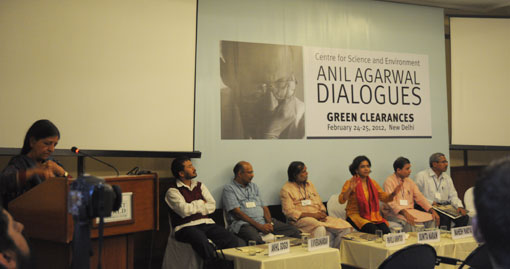MOEF intervenes to enhance transparency

The Centre for Science and Environment organised a two-day ‘Anil Agarwal Dialogue’ on Green Clearances held on February 24-25, 2012. The objective of the conference was to discuss various issues related to environmental and forest clearance. In a recent study, CSE had analysed the clearances granted by the Union ministry of environment and forests over the last five years – and found that the country saw more clearances in this period than those planned for even during the 11th and 12th Five Year Plans. The conference was organised to bring together all the stakeholders; government, industry and civil society on a common platform to discuss the issues plaguing Green clearances. It was attended by over 150 participants from about 100 organisations spread in different parts of the country. Participants and panelists mooted over the lacunas in the proceedings of environment and forest clearance and came out with a set of recommendations. Some of the recommendations suggested by participants from the two day dialogue were:-
-
People’s consent should be a must before granting clearance. Public Hearing and its report must become a part of the decision making process.
-
The Environmental Clearance Appraisal Committee (EAC) should be reformed – it should have the required expertise, and the process must be completely transparent. Affected communities must have a say in the decision making.
-
Post-project monitoring should be made mandatory. (See Two-day NGOs’ conclave ends with a charter of demands, http://cseindia.org/content/aagarwal-dialogue)
Shri T Chaterjee, Secretary and Shri Rajiv Gauba, Joint Secretary participated in the Dialogue representing Ministry of Environment and Forests. Both recognised the fact that process of environment and forest clearance is not working in the country. They promised to work towards improvement but also categorically stated not to expect anything overnight.
Ministry aims for transparency
One of the major issues raised by NGOs across the country was unavailability of EIA report for the public to make informed decision. The NGOs asserted that EIA reports are not available or in some cases only summary of EIA reports are available which are not of much use. In the absence of EIA reports people are not able to raise valid questions to the proponent in the public hearing. The Ministry of Environment and Forests took note of people's plea and passed an order on March 20, 2012 instructing Expert Appraisal Committees (EACs) /State Environmental Impact Assessment Authority (SEIAA) to upload all relevant information related to Environment Impact assessment on the website of MoEF or SEIAA. The documents would include Form I, Form IA, Pre-feasibility report, draft TORs, EIA report, filled in questionnaire for environmental appraisal projects and public hearing proceedings. In addition, ministry has also asked to upload report of any site visit undertaken by EAC/SEAC on the website. The order comes into effect from 1st April, 2012 still none of the SEIAAs or MoEF website has uploaded any information.
Another important initiative undertaken by MoEF is to constitute a committee for inspection and monitoring of following areas:
-
Implementation of conditions and safeguards laid down for projects/ activities covered under Environmental CRZ clearances;
-
To monitor the implementation of conditions and safeguards stipulated by Central Government in the proposals approved under Forest (Conservation) Act, 1980; and
-
To undertake physical inspection and monitoring of sites in cases of diversion of forest land involving an area of more than 40 ha and all mining projects.
The reason provided by ministry for constituting such committee was heavy workload of Regional Offices functioning under the Ministry. As of now, ministry has only six Regional offices at Bangalore, Bhopal, Bhubaneswar, Chandigarh, Lucknow and Shillong for inspection and monitoring of thousands of project it clears every year.
Constitution of a committee for inspection and monitoring of specific projects is a good move by Ministry however it may prove to be cumin in camel’s mouth since most of the projects accorded clearance requires inspection and monitoring. The Ministry needs to re-draw its strategy if it is really concerned about inspection and monitoring of projects that it has cleared.
![]()
Written by: Nivit Kumar Yadav
Email: nivit@cseindia.org
Previous Training Programmes
Story
Newsletter
Down to Earth
.jpg)
November 23, 2017

November 23, 2017

November 23, 2017

November 23, 2017
MoEF's clearance must for mining minor minerals, too: Supreme Court

November 23, 2017

November 23, 2017
MoEF failed to protect environment: Public Accounts Committee

November 23, 2017
IEP Resources
| Studies/Publications | |
| Into the Furnace: Environment Status of the Indian Steel Sector | |
| Excreta Matters: 7th State of India's Environment Report | |
| Guidelines for Implementation of E-Waste Rules 2011 | |
| MoEF Annual Report: 2011-12 | |
| Buildings Earthscrapers Environment Impact Assessment of Buildings | |
| Contributing Authors | |
| Chandra Bhushan | |
| chandra@cseindia.org | |
| Nivit Kumar Yadav | |
| nivit@cseindia.org | |
Share this article